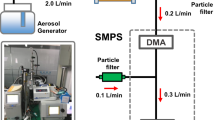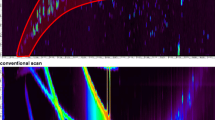Abstract
The increasing use and production of nanomaterials have led to growing concern over the release of new pollutants to the environment. Fullerenes have been a subject of intense research, both because of their unique chemistry and because of technological applications. The development of analytical methods to quantify the fullerenes in complex sample matrices is a crucial step in the study of their occurrence and exposure, and thus in risk assessment. This paper reports the development and optimisation of a method combining liquid chromatography with ion-trap mass spectrometry (LC–ITMS) for analysis of the fullerene C60. Under the optimised chromatogram conditions, a C18 analytical column had good selectivity for fullerenes C60 and C70, with retention times of 3.0 and 4.1 min, respectively. Mass spectrometric detection was tested and optimised using three common ionisation techniques—atmospheric-pressure chemical ionisation (APCI), atmospheric-pressure photoionisation (APPI), and electrospray ionisation (ESI). The molecular ion was most abundant for C −60 (m/z = 720) in APCI and APPI, whereas adduct ions were formed with the molecular ion in ESI. Finally, the performance of the three ionisation techniques examined was compared by use of five validation criteria. The instrument detection limit (8 ng mL−1), quantification limit (27 ng mL−1), detection sensitivity (90.2 ng mL−1), linear range (8–1,000 ng mL−1), and repeatability (15 %) of APPI make it the most promising ionisation technique for fullerene C60 analysis.




Similar content being viewed by others
References
Handy RD, Owen R, Valsami-Jones E (2008) The ecotoxicology of nanoparticles and nanomaterials: current status, knowledge gaps, challenges, and future needs. Ecotoxicology 17:315–325
Ju-Nam Y, Lead JR (2008) Manufactured nanoparticles: an overview of their chemistry, interactions and potential environmental implications. Sci Total Environ 400:396–414
Buseck PR, Tsipursky SJ, Hettich R (1992) Fullerenes from the geological environment. Science 257:215–217
Heymann D, Chibante F, Brooks RR, Wolbach WS, Smalley RE (1994) Fullerenes in the cretaceous-boundary layer. Science 265:645–647
Sanchís J, Berrojalbiz N, Caballero G, Dachs J, Farré M, Barceló D (2011) Occurrence of aerosol-bound fullerenes in the Mediterranean Sea atmosphere. Environ Sci Technol. doi:10.1021/es2000758m
Jafvert CT, Kulkarni PP (2008) Buckminsterfullerene's (C60) octanol–water partition coefficient (Kow) and aqueous solubility. Environ Sci Technol 42:5945–5950
Ma X, Bouchard D (2009) Formation of aqueous suspensions of fullerenes. Environ Sci Technol 43:330–336
Tervonen K, Waissi G, Petersen EJ, Akkanen J, Kukkonen JVK (2010) Analysis of fullerene-C60 and kinetic measurements for its accumulation and depuration in Daphnia magna. Environ Toxicol Chem 29:1072–1078
Andrievsky GV, Klochkov VK, Bordyuh AB, Bovbeshko GI (2002) Comparative analysis of two aqueous-colloidal solutions of C60 fullerene with help of FTIR reflectance and UV–VIS spectroscopy. Chem Phys Lett 364:8–17
Brant J, Lecoanet H, Wiesner MR (2005) Aggregation and deposition characteristics of fullerene nanoparticles in aqueous systems. J Nanopart Res 7:545–553
Kim KT, Jang MH, Kim JY, Kim SD (2010) Effect of preparation methods on toxicity of fullerene water suspensions to Japanese medaka embryos. Sci Total Environ 408:5606–5612
Isaacson C, Zhang W, Powell T, Ma X, Bouchard D (2011) Temporal changes in aqu/C60 physical–chemical, deposition and transport characteristics in aqueous systems. Environ Sci Technol 45:5170–5177
Scharff P, Risch K, Carta-Abelmann L, Dmytruk IM, Bilyi MM, Golub OA, Khavryuchenko AV, Buzaneva EV, Aksenov VL, Avdeev MV, Prylutskyy YI, Durov SS (2004) Structure of C60 fullerene in water: spectroscopic data. Carbon 42:1203–1206
Kawano SI, Murata H, Mikami H, Mukaibatake K, Waki H (2006) Method optimization for analysis of fullerenes by liquid chromatography/atmospheric pressure ionization mass spectrometry. Rapid Commun Mass Sp 20:2783–2785
Chen Z, Westerhoff P, Herckes P (2008) Quantification of C60 fullerene concentrations in water. Environ Toxicol Chem 27:1852–1859
Wang C, Shang C, Westerhoff P (2010) Quantification of fullerene nC60 in wastewater by high-performance liquid chromatography with UV–vis spectroscopic and mass spectrometric detection. Chemosphere 80:334–339
Benn TM, Pycke BFG, Herckes P, Westerhoff P, Halden RU (2011) Evaluation of extraction methods for quantification of aqueous fullerenes in urine. Ana Bioanal Chem 399:1631–1639
van Wezel AP, Morinière V, Emke E, ter Laak T, Hogenboom AC (2011) Quantifying summed fullerene nC60 and related transformation products in water using LC LTQ Orbitrap MS and application to environmental samples. Environ Int 37:1063–1067
Isaacson CW, Bouchard DC (2010) Asymmetric flow field flow fractionation of aqueous C60 nanoparticles with size determination by dynamic light scattering and quantification by liquid chromatography atmospheric pressure photo-ionization mass spectrometry. J Chromatogr A 1217:1506–1512
Isaacson CW, Usenko CY, Tanguay RL, Field JA (2007) Quantification of fullerenes by LC/ESI–MS and its application to in Vivo toxicity assays. Anal Chem 79:9091–9097
Farré M, Pérez S, Gajda-Schrantz K, Osorio V, Kantiani L, Ginebreda A, Barcelό D (2011) First determination of C60 and C70 fullerenes and N-methylfulleropyrrolidine C60 on the suspended material of wastewater effluents by liquid chromatography hybrid quadrupole linear ion trap tandem mass spectrometry. J Hydrol 383:44–51
Ellison SLR, Barwick VJ, Duguid Farrant TJ (2009) Practical statistics for the analytical scientist – a bench guide. Cambridge
Jandera P, Guiochon G (1991) Effect of the sample solvent on band profiles in preparative liquid chromatography using non-aqueous reversed-phase high-performance liquid chromatography. J Chromatogr 588:1
Kele M, Compton RN, Guiochon G (1997) Optimization of the high-performance liquid chromatographic separation of fullerenes using 1-methylnaphthalene as the mobile phase on a tetraphenylporphyrin-silica stationary phase. J Chromatogr A 786:31–45
Anacleto JF, Boyd RK, Quilliam MAJ (1993) High performance liquid chromatographic–mass spectrometric detection of giant fullerenes. J High Res Chromatogr 16:85–89
Wilson SR, Wu YH (1993) Detection of methoxylated anions of fullerenes by electrospray ionization mass spectrometry. J Am Chem Soc 115:10334–10337
van Berkel GJ, Zhou F, Aronson JT (1997) Changes in bulk solution pH caused by the inherent controlled-current electrolytic process of an electrospray ion source. Int J Mass Sp 162:55
Rober EA (2003) Liquid Chromatography –mass spectrometry: an introduction. Huddersfield, UK
Acknowledgments
Ms Hannele Leskinen is acknowledged for her technical help during the experiments. The authors thank the association Maa-ja Vesitekniikan Tuki ry and the Ministry of the Environment for financial support.
Author information
Authors and Affiliations
Corresponding author
Rights and permissions
About this article
Cite this article
Li, L., Huhtala, S., Sillanpää, M. et al. Liquid chromatography–mass spectrometry for C60 fullerene analysis: optimisation and comparison of three ionisation techniques. Anal Bioanal Chem 403, 1931–1938 (2012). https://doi.org/10.1007/s00216-012-6005-8
Received:
Revised:
Accepted:
Published:
Issue Date:
DOI: https://doi.org/10.1007/s00216-012-6005-8




